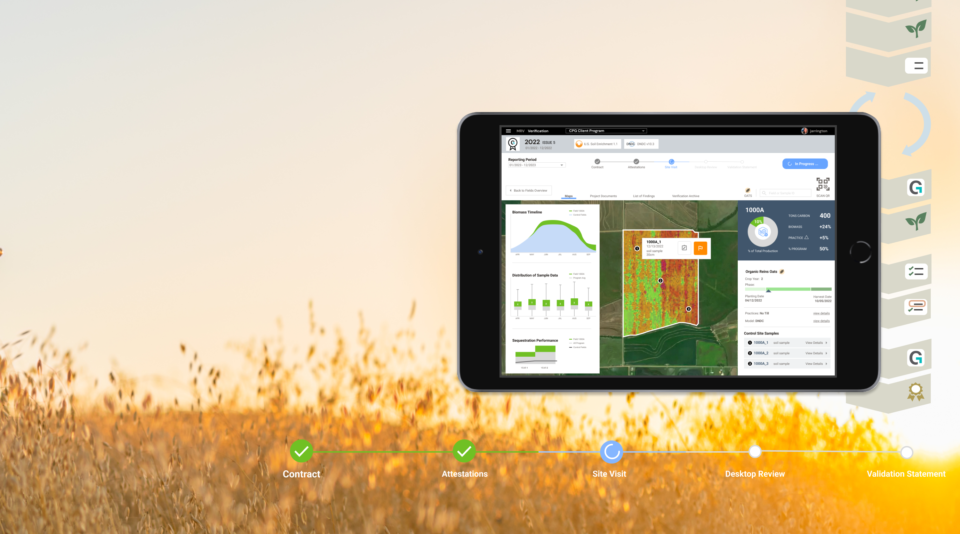Verifying Carbon Credits
Climate Storytelling, Data Visualization, Digital MRV Design
Regrow Ag is on a mission to change the world through agriculture by unlocking the profitability of resilient practices. I researched carbon credit pathways and crafted a workflow for verification in a proposal for the team.
The Situation
Regrow has technology that monitors the health and yield of industrial crops and predictive software that sets sustainability goals for updated farming practices on the ground. The team sought to scale their impact by entering the carbon credit market.
The team was challenged with matching their results with nascent rules and multiple standards boards. Regrow approached me to develop a workflow and UX concept for field verifiers that makes certifying Scope 3 emission reductions easier.
Verifying CO2 Reductions
With a goal to acquire carbon credits for their work and maintain a certification, the team had a serious challenge ahead. Currently there are several certification boards and no global standard to follow.
Many boards like Gold Standard lack pathways in agriculture for carbon credits. Regrow achieved a partnership with certification body, SustainCERT, as a first step.
Verifying CO2 emission reductions is complicated and lengthy.
My Approach
User Research Unlocks Better Solutions.
Events and people are connected in ways that may not be obvious but have serious implications for the success or failure of a software product. User research surfaces the key players and actions to deliver success.
I focused on a credit protocol and verifier that best supported Regrow. I then studied the verification process to describe a path that made the process easier.
Process Analysis
How a cereal brand gets certified for carbon credits.
To build something useful, I needed to understand the alignment between verification work and the procedures used at Regrow. There are hundreds if not thousands of protocols and certification guidelines out there.
Finding and using protocols that are relevant to Regrow’s process was challenging but critical as there are no centralized standards. I focused on the Soil Enrichment Protocol for my case study.
Lead Verifier - Their Journey

I reviewed job descriptions for verifiers and contacted people who do verification work at Aster Global, to confirm the protocols called into play in this scenario. I also reached out to regenerative farms for their view of the process.
Verification teams go out and physically inspect farm fields, take samples, retrace math, and review scientific protocols. They then flag items for producers to change to maintain certification.
The team conducts a 3 part review of the farm project and are specifically looking for OVERESTIMATION of a project’s CO2 reductions. They focus on three core areas for their report.

Verifiers review the project attestation papers to ensure compliance with a crediting program. These papers include the project plan, data collection, equipment, calculations, and people trained for the project.

Verifiers go onsite to inspect the project emission sources, take samples, retrace the project calculations, and confirm the project emission reductions. Any inconsistencies are flagged. The findings are compiled in a report for certification.

Wrapping up the process after reviewing site operations and project attestations, the verifiers meet with the project team to review the report and will then submit a summary to the certification board.
Verifier Challenges

Weather and Access
It’s a challenge to be in the elements, with limited cell or data reception.

Complicated Growing Cycles
Crop reviews often overlap and do not fit neatly into standardized schedules.

Manual Record Keeping
Certification programs rely on paper documentation and rudimentary filing systems.

Recalculation
Manual workflows and multiple protocol make accuracy and consistent data difficult.
UX & Concepts
















